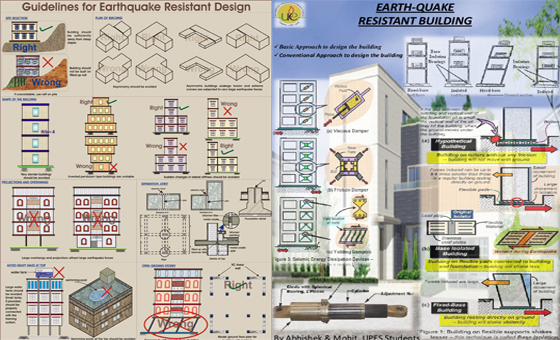How to make earthquake resistant design with some fundamental elements

Usually, structures on the earth bear two types of loads which range from static and dynamic. Static loads are persistent with time whereas dynamic loads differ with time. While designing most of the civil engineering structures, it is supposed that all functional loads are static.
The impact of dynamic loads is not assessed as the structure is hardly dependent on dynamic loads. Besides, its concern in analysis creates the solution more complex and time consuming. So, omitting the dynamic forces may lead to disaster, specifically for earthquake. Now-a-days, the civil engineering structures are designed in such a manner so that they can resist dynamic loads, specifically, earthquake induced load.
The dynamic force belongs to an earthquake force that is caused due to quick movement along the plane of faults inside earth's crust. This unexpected movement of fault discharges excessive energy as seismic waves, which are transferred to the structures via their foundations, and result in arranging the structure in motion. These motions contain complicated characteristics in nature and cause sudden horizontal and vertical oscillations in structures, which provide accelerations, velocities and displacements in the structure. The induced accelerations produce inertial forces in the structure, which are equivalent to the acceleration of the mass and functioning opposite to the ground motion.
The energy generated in the structure through the ground motion is dissipated by the internal friction inside the structural and non-structural members. This dissipation in energy is known as damping. The structures always contain some fundamental damping that reduces in due course as soon as the seismic excitation is ceased. These dissipative or damping forces are characterized by viscous damping forces, which are equivalent to the velocity driven in the structure. The constant of proportionality is known as linear viscous damping. The resisting force in the structures is equivalent to the deformation driven in the structure throughout the seismic excitation. The constant of proportionality is described as stiffness of structure. Stiffness significantly impacts how the structure the earthquake generated forces. Based on the stiffness, the structure is categorized as brittle or ductile.
Brittle structure that contains higher stiffness becomes less resilient throughout earthquake whereas ductile structure can withstand earthquakes efficiently. This action of structure induces a supplementary characteristic termed as ductility. Ductility refers to the capacity of structure to bear distortion or deformation devoid of damage or failure.

To read the complete article, go through the following link
theconstructor.org
|